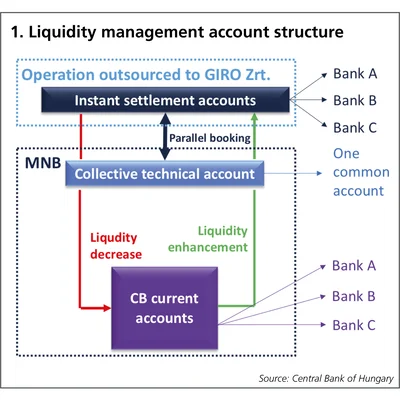
Payments and market infrastructure development – retail: Central Bank of Hungary
Strict implementation rules and unique operational setup supported e-payments shift during pandemic

The Covid-19 pandemic has reinforced the importance of a popular mantra among central banks: that consumers should have the freedom to choose their method of payment. In many jurisdictions, cashless payments have experienced accelerated growth in the past year, as physical interactions were discouraged, and shopping increasingly occurs online.
The timely introduction of the Central Bank of Hungary’s new instant payment system was crucial to offering a convenient choice of payment during the pandemic. The system is open to banks and non-bank payment service providers. It also includes a directory service so consumers can use their mobile phone numbers and email addresses to send payments.
“There is a new ecosystem in the Hungarian payment system today, and now everybody can use it,” says Mihály Patai, deputy governor of the central bank.
Lajos Bartha, executive director of the Central Bank of Hungary, adds: “The instant payment system has facilitated the preferred means of payment during this unique year for consumer behaviour, but the ultimate goal has been to create a new normal of instant payments in Hungary.”
The instant payment system has facilitated the preferred means of payment during this unique year for consumer behaviour, but the ultimate goal has been to create a new normal of instant payments in Hungary
Lajos Bartha, Central Bank of Hungary
The instant payment system was launched on March 2, 2020, as Europe was hit by a first wave of coronavirus-related lockdowns. The number of small-value credit transfers rose 13% in March compared with the same month in 2019, and increased further still in the following months. And by September 2020, 48% of transactions – close to 33 million payments – were being processed on the instant payment platform, with the system executing 99% of these transactions within the specified five-second limit and 95% within two seconds.
“The smooth functioning of the system during this period speaks to its success and, I think, importance of introducing it when we did,” says Zsolt Kada, chief information officer at Hungarian automated clearing house (ACH) Giro.
Strict approach
Introducing a new payment system is not without its challenges. In addition, the Hungarian banking sector has a large proportion of foreign-owned banks, which have appeared reluctant to invest in past payment developments in the country. Furthermore, to avoid a renewal of the central bank’s entire system by extending the real-time gross settlement (RTGS) opening hours, the central bank also developed a unique operating setup and liquidity management tool.
Learning from past experiences of the banking sector’s unwillingness to positively engage in implementing the country’s intraday clearing system in 2012, the central bank adopted a strict approach for the instant payment system.
“We learned from this previous exercise that we did not want ongoing debates with the banking sector, so, from the beginning, we told them that this will be a mandatory exercise,” says Bartha.

To do this, it changed the central bank decree in 2017 – stating that by July 1, 2019, credit transfers below 10 million Hungarian forint (roughly $34,000 or €28,000) had to be made within five seconds. The central bank also set out a demanding set of protocols, testing schedules and harsh consequences for missing deadlines.
To support banks in meeting the requirements, the central bank and ACH adopted a tightly controlled and centralised communication strategy. Message implementation guidelines, workshops, an information website and mailing list were all used to ensure the banking sector fulfilled the strict protocols.
Despite the test plans and schedule being “hard to fulfil”, György Fekete, executive director of IT at Gránit Bank, tells Central Banking he welcomed the strict approach: “It was the only way to implement such a complex system – without this strict control, the deadline would not have been met.”
“The whole project team needed the very clear communication it received from the central bank, and Gránit Bank allocated all resources necessary to reach the deadline, because it was not a question to not fulfil it. We all felt the pressure to meet the deadline, but we were convinced that the project would bring significant improvements for the whole Hungarian banking system.”
Operationally unique
The central bank developed an approach to address potential liquidity shortages during periods when its RTGS system was not operational. Discounting the costly extension of the operating hours of the RTGS system, the central bank opted for pre-funded accounts and an overnight liquidity tool.
In the Hungarian system, settlement of instant payments is outsourced to the Hungarian ACH, which also manages the instant clearing of transactions. Each bank or payment service provider must dedicate a portion of liquidity available in the RTGS system to the instant payment system in advance. In practice, this means participants pre-fund an individual instant payment account technically held at the ACH with central bank money.
“If both IT service parts are operated by the same organisation, it is more easily controllable and leverages the IT synergies,” says the ACH’s Kada.
“The Hungarian banks agreed that this model is optimal to mitigate their credit risk, and with the help of our overnight liquidity pool service, every participant is safe from any possible liquidity risk.”

Outside the operating hours of the RTGS, the liquidity pool service automatically reviews, calculates and allocates, when necessary, overdrafts to participants that face imbalances in their outgoing and ingoing payments. The credit lines are backed by securities pledged for the central bank in the CSD and loaded into a credit line register, a system developed and operated by Giro for the purpose of providing instant credits. The next morning, on an RTGS business day, the banks repay any borrowed funds from the pool along with an interest rate of 200 basis points above the central bank’s overnight loan facility. This repayment and the interest payment functionalities have also been automated and integrated into the opening process of the RTGS.
“The automated credit mechanism has been set up to provide an additional line of defence in terms of the periods outside the operating hours of the RTGS and instead of keeping the RTGS open 24/7,” says the Central Bank of Hungary’s Bartha.
Consumers are benefiting
While overcoming these challenges reflects the central bank’s determination in developing the new payment system, its success or otherwise ultimately rests on its ability to meet consumer expectations and demand. Early results from the Hungarian instant payment system suggest it is already having a positive impact on consumers.
Roughly half of the previous intraday credit transfers are instead now being conducted using the system. This figure is expected to rise, since corporate transfers were only added in a second phase of the project in September 2020.
“Payments overnight and at weekends are increasing every week, which suggests clients are becoming more familiar with the service, and that they like it,” says Fekete.
As of October, 34% of transactions initiated in the instant payment system were either during the weekends or overnight.
Prior to the pandemic, roughly 80% of transactions in Hungary were made using cash or postal cheques. Purchases of properties and cars were almost entirely done via cash. The data suggests that consumers who typically paid with cash are increasingly turning to the instant payment system via the proxy service, using their mobile numbers and emails to send payments, particularly during the pandemic, says Kada.
Consumers are also benefiting from recent innovations in the banking sector, driven by the new infrastructure capabilities. Many banks have released new mobile applications since the launch of the system, to include proxy service, QR code capabilities for retailers and request-to-pay messaging features.
“The new system is already very useful, and has real advantages to customers, but there is also a huge potential in it,” says Fekete.
The Central Banking Awards were written by Christopher Jeffery, Daniel Hinge, Dan Hardie, Rachael King, Victor Mendez-Barreira, William Towning and Alice Shen
Only users who have a paid subscription or are part of a corporate subscription are able to print or copy content.
To access these options, along with all other subscription benefits, please contact info@centralbanking.com or view our subscription options here: http://subscriptions.centralbanking.com/subscribe
You are currently unable to print this content. Please contact info@centralbanking.com to find out more.
You are currently unable to copy this content. Please contact info@centralbanking.com to find out more.
Copyright Infopro Digital Limited. All rights reserved.
As outlined in our terms and conditions, https://www.infopro-digital.com/terms-and-conditions/subscriptions/ (point 2.4), printing is limited to a single copy.
If you would like to purchase additional rights please email info@centralbanking.com
Copyright Infopro Digital Limited. All rights reserved.
You may share this content using our article tools. As outlined in our terms and conditions, https://www.infopro-digital.com/terms-and-conditions/subscriptions/ (clause 2.4), an Authorised User may only make one copy of the materials for their own personal use. You must also comply with the restrictions in clause 2.5.
If you would like to purchase additional rights please email info@centralbanking.com






